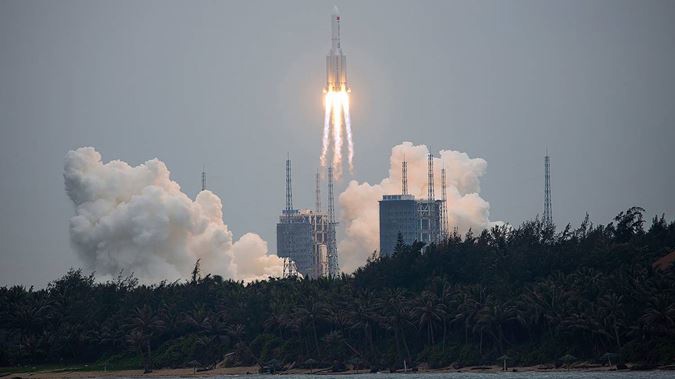
Debris from a huge Chinese rocket could re-enter Earth's atmosphere close to New Zealand.
The European Space Agency has confirmed China's Long March 5B rocket – which was launched into the skies with much fanfare a mere week ago – has dropped into low Earth orbit.
US space research organisation the Aerospace Corporation has forecast the 18-tonne piece of ejected rocket will re-enter the Earth's atmosphere around 3pm-4pm today NZ time.
The current trajectory puts the space junk close to New Zealand's North Island as it renters.
However, those projections are highly uncertain and even when it renters its likely to travel some distance before hitting land or sea. Much, but by no means all, of the rocket is likely to burn up before it reaches the surface.
It could make contact with the Earth's surface anywhere between the latitudes of 41.5 degrees north or south, a wide band that includes much of Asia, Africa, the Americas and Australia as well as the central portions of the Atlantic and Pacific oceans south of New York, Madrid and Beijing and north of Tasmania and Buenos Aires.
Should we be worried about the approaching rocket? Do we need to grab a towel like Arthur Dent was advised in Hitchhiker's Guide to the Galaxy?
Aussie scientist, Dr Fabian Zander, from University of Southern Queensland's Institute for Advanced Engineering and Space Sciences, said there was no way to be certain where it would land.
"The short answer is we don't really know where it's going to come down," he told an Australian TV network.
Thousands of space watchers are busily tracking the Long March 5B's journey across the sky on a YouTube video that currently predicts the lump of space junk will harmlessly fall into the ocean missing entire continents.
Jonathan McDowell, an astrophysicist at Harvard University's Astrophysics Centre, told CNN people should not be losing sleep over the impending collision.
"I don't think people should take precautions," he said. "The risk that there will be some damage or that it would hit someone is pretty small – not negligible, it could happen – but the risk that it will hit you is incredibly tiny.
"And so I would not lose one second of sleep over this on a personal threat basis.
"There are much bigger things to worry about."
China 'negligent'
Chinese Government mouthpiece the Global Times also downplayed any threat to human life or buildings, claiming reports it was out of control were foreign hype.
"Most of the debris will burn up during re-entry … leaving only a small portion that may fall to the ground, which will potentially land on areas away from human activities in the ocean," editor of Aerospace Knowledge Wang Yanan said, according to the outlet.
But talking to the BBC Jonathan McDowell from the US' Harvard-Smithsonian Centre for Astrophysics wasn't a good look for Beijing.
"It is indeed seen as negligence.
"This is the second launch of this rocket; the debris in Ivory Coast last year was from the previous launch, i.e. a basically identical rocket.
"These two incidents are the two largest objects deliberately left to re-enter uncontrolled since Skylab in 1979."
The Skylab impacted with Western Australia leaving space junk debris scattered across the state.
What is the Long March 5B rocket?
The launch was the second of 11 missions to construct and provision China's new space station. The module was propelled by a powerful Long March 5B rocket, the second stage of which is currently descending Earthward.
However, from a low Earth orbit, bodies are drawn gradually by gravity towards the surface of the planet. But the Long March rocket is so massive – 30m long and weighing up to 22 tonnes – that is it unlikely to burn up entirely.
"We have the capability to do a lot of things, but we don't have a plan to shoot it down as we speak," US Defence Secretary Lloyd Austin told reporters.
"We're hopeful that it will land in a place where it won't harm anyone. Hopefully in the ocean, or someplace like that."
However, even if fragments of the rocket do land on buildings, the speed of impact will only be about 200km/h. While that sounds quite fast, it's nothing compared to a meteorite which can reach speeds of 36,000km/h as it hurtles towards Earth.
According to SpaceNews, the rocket that is currently on a one-way track towards Earth is the second Long March 5B which headed out on April 28.
It successfully propelled the Tianhe core module for China's space station into orbit.
Lots of people turned out to see the spectacle in person.
However, it soon became apparent the second stage had reached orbit and was now heading home – allegedly uncontrollably.
China's Foreign Ministry spokesman Wang Wenbin told a press conference that it was "common practice across the world for upper stages of rockets to burn up while re-entering the atmosphere".
While there was a risk associated with the re-entry, this was "extremely low" – a view shared by space debris modelling experts.
Take your Radio, Podcasts and Music with you









